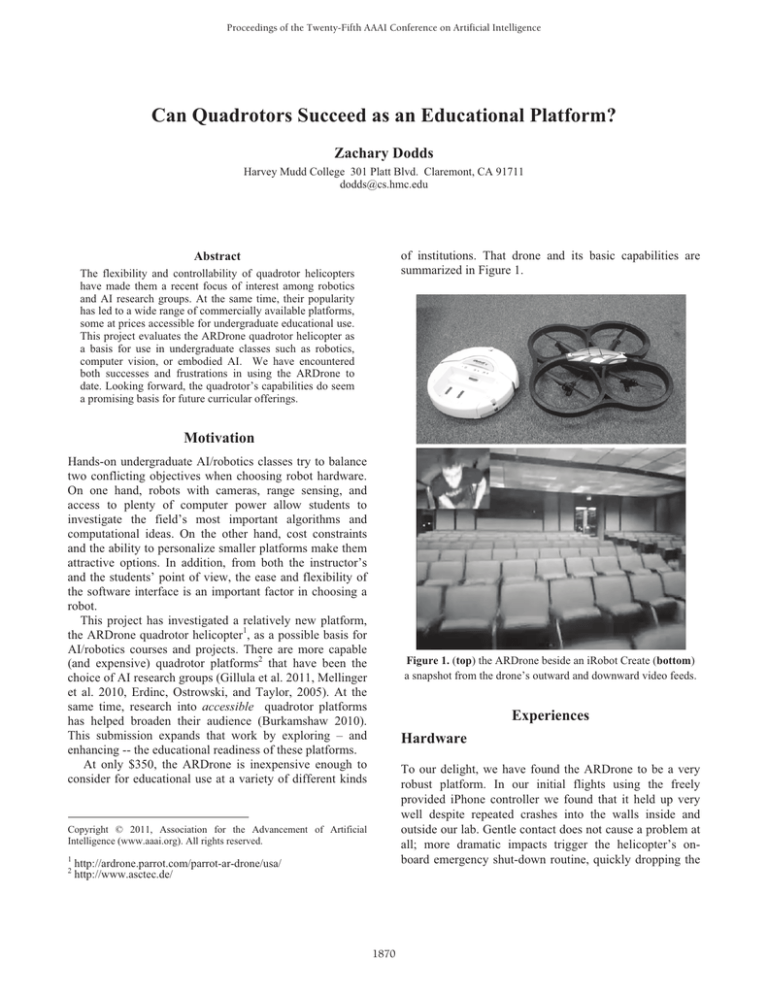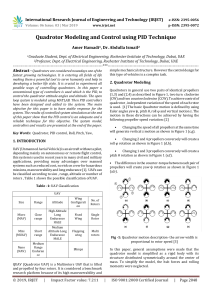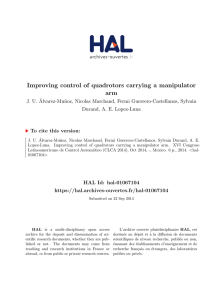
Proceedings of the Twenty-Fifth AAAI Conference on Artificial Intelligence
Can Quadrotors Succeed as an Educational Platform?
Zachary Dodds
Harvey Mudd College 301 Platt Blvd. Claremont, CA 91711
dodds@cs.hmc.edu
of institutions. That drone and its basic capabilities are
summarized in Figure 1.
Abstract
The flexibility and controllability of quadrotor helicopters
have made them a recent focus of interest among robotics
and AI research groups. At the same time, their popularity
has led to a wide range of commercially available platforms,
some at prices accessible for undergraduate educational use.
This project evaluates the ARDrone quadrotor helicopter as
a basis for use in undergraduate classes such as robotics,
computer vision, or embodied AI. We have encountered
both successes and frustrations in using the ARDrone to
date. Looking forward, the quadrotor’s capabilities do seem
a promising basis for future curricular offerings.
Motivation
Hands-on undergraduate AI/robotics classes try to balance
two conflicting objectives when choosing robot hardware.
On one hand, robots with cameras, range sensing, and
access to plenty of computer power allow students to
investigate the field’s most important algorithms and
computational ideas. On the other hand, cost constraints
and the ability to personalize smaller platforms make them
attractive options. In addition, from both the instructor’s
and the students’ point of view, the ease and flexibility of
the software interface is an important factor in choosing a
robot.
This project has investigated a relatively new platform,
the ARDrone quadrotor helicopter1, as a possible basis for
AI/robotics courses and projects. There are more capable
(and expensive) quadrotor platforms2 that have been the
choice of AI research groups (Gillula et al. 2011, Mellinger
et al. 2010, Erdinc, Ostrowski, and Taylor, 2005). At the
same time, research into accessible quadrotor platforms
has helped broaden their audience (Burkamshaw 2010).
This submission expands that work by exploring – and
enhancing -- the educational readiness of these platforms.
At only $350, the ARDrone is inexpensive enough to
consider for educational use at a variety of different kinds
Figure 1. (top) the ARDrone beside an iRobot Create (bottom)
a snapshot from the drone’s outward and downward video feeds.
Experiences
Hardware
To our delight, we have found the ARDrone to be a very
robust platform. In our initial flights using the freely
provided iPhone controller we found that it held up very
well despite repeated crashes into the walls inside and
outside our lab. Gentle contact does not cause a problem at
all; more dramatic impacts trigger the helicopter’s onboard emergency shut-down routine, quickly dropping the
Copyright © 2011, Association for the Advancement of Artificial
Intelligence (www.aaai.org). All rights reserved.
1
2
http://ardrone.parrot.com/parrot-ar-drone/usa/
http://www.asctec.de/
1870
robot to the ground. Both the forward-facing and the
downward-facing cameras have performed reliably.
Similarly, the ultrasonic sensor that estimates height above
the groundplane works exactly as well as any small-robot
sonar does: sufficient for hovering, though not precise.
Software
The software has been less forgiving than the hardware in
our experience. We have successfully used both the
provided C++ software development kit (SDK) and a
custom-built Java interface, adapted from contributions by
the ARDrone’s user community. Although there are user
reports of successful installations of the SDK on operating
systems other than Ubuntu, our efforts to that end (on both
Mac OS X and Windows) have not yet been successful. In
our exhibition at AAAI we hope to shed more insight – and
success – in using those operating systems. Under Linux,
however, the ARDrone SDK works as advertised. As of
this submission, students in our AI topics in vision and
robotics elective have successfully processed video from
both cameras, as shown in Figure 1.
To offer an interface using an OS and language with
which high-school students are more likely to be
comfortable, we have been developing a pure-Java library
that communicates with the drone via its ASCII protocol
directly. Starting from contributions by the ARDrone’s
user community, we have integrated access to the control
and the forward-camera video stream. Because the
interface is Java, a high-school junior has been able to use
it to demonstrate mixed-modality robot coordination. The
system controls both a Create and an ARDrone (Figure 2):
Figure 2. Critical moments from a drone-enabled navigation task:
(top left) the initial configuration of drone, Create, and obstacle
(top right) the drone hovering over the scene (middle) an image
from the drone’s downward-facing camera (bottom) the
computed shortest path for the Create, available because of the
addition of overhead sensing on the quadrotor helicopter.
1. When the Create realizes that it cannot proceed to the
goal above the wall, it signals the drone to take off and
hover over the scene.
2. As the drone hovers, its video feed is processed to
determine whether exploration to the right or to the
left is more promising.
3. The system signals the preferred direction, extracted
from the overhead view, to the ground-based robot,
which then proceeds to the goal.
References
Gillula, J., Hoffmann, G. M., Huang, H., Vitus, M. P. and
Tomlin, C. J. 2011. Applications of Hybrid Reachability
Analysis to Robotic Aerial Vehicles. The International Journal of
Robotics Research 30(3) 335-354.
Mellinger, D., Shomin, M., Michael, N., and Kumar, V. 2010.
Cooperative Grasping and Transport using Multiple Quadrotors.
Proceedings, 10th annual Symposium on Distributed Autonomous
Robotic Systems, Lausanne, Switzerland, Nov 2010.
Erdinc, A., Ostrowski, J. P., and Taylor, C. J. 2005. Control of a
Quadrotor Helicopter Using Dual Camera Visual Feedback. The
International Journal of Robotics Research 24(5) 329-341.
Burkamshaw, L. K. 2010. Towards a Low-cost Quadrotor
Research Platform. Master’s Thesis, Naval Postgraduate School,
March 2010.
Perspective
Because we have been developing the Java API along with
this student’s project, each effort has pushed the other
forward. We feel that this task’s ambition and feasibility
shows that the ARDrone holds considerable educational
promise. The project itself succeeded, too, taking first
place in Los Angeles’s science fair in April 2010. In
August we will report on strides we have taken to make
quadrotor helicopters as capable and as accessible a
resource as possible for AI educators.
1871







